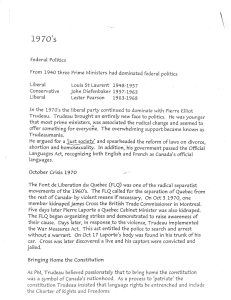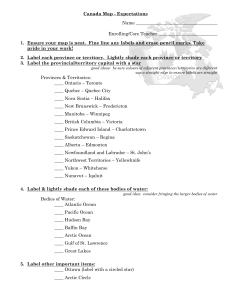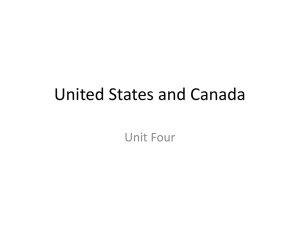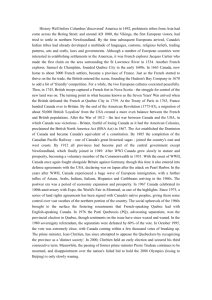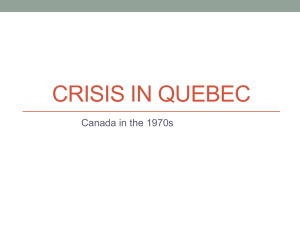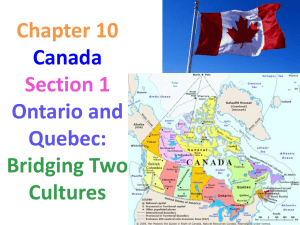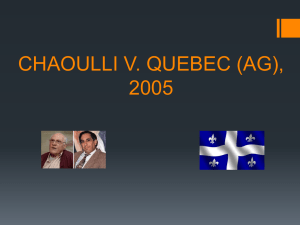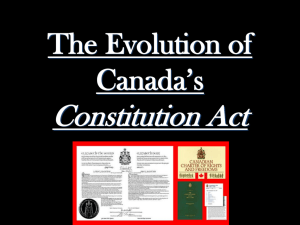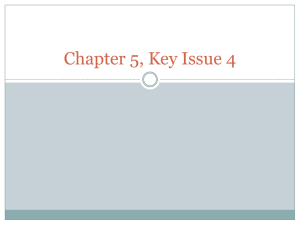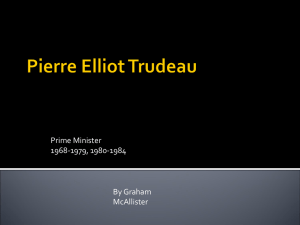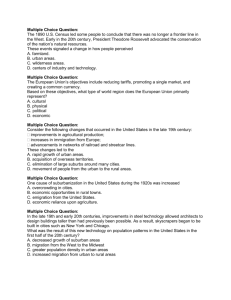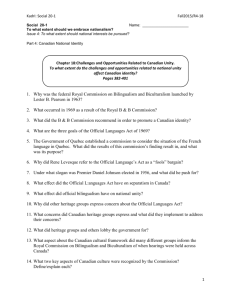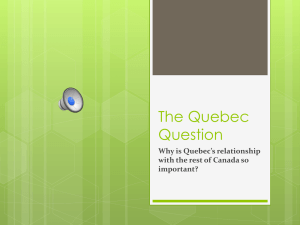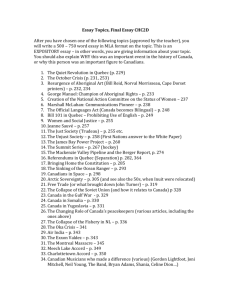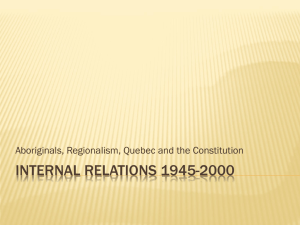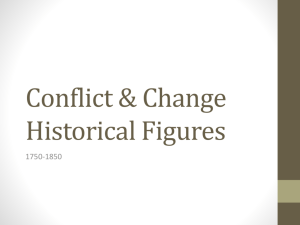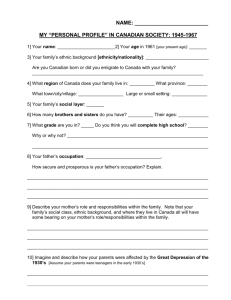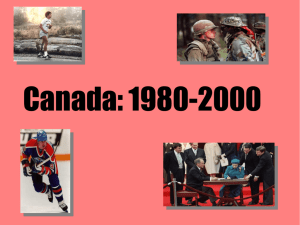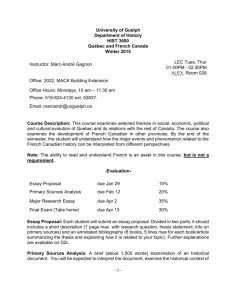A Short History of Canada
advertisement
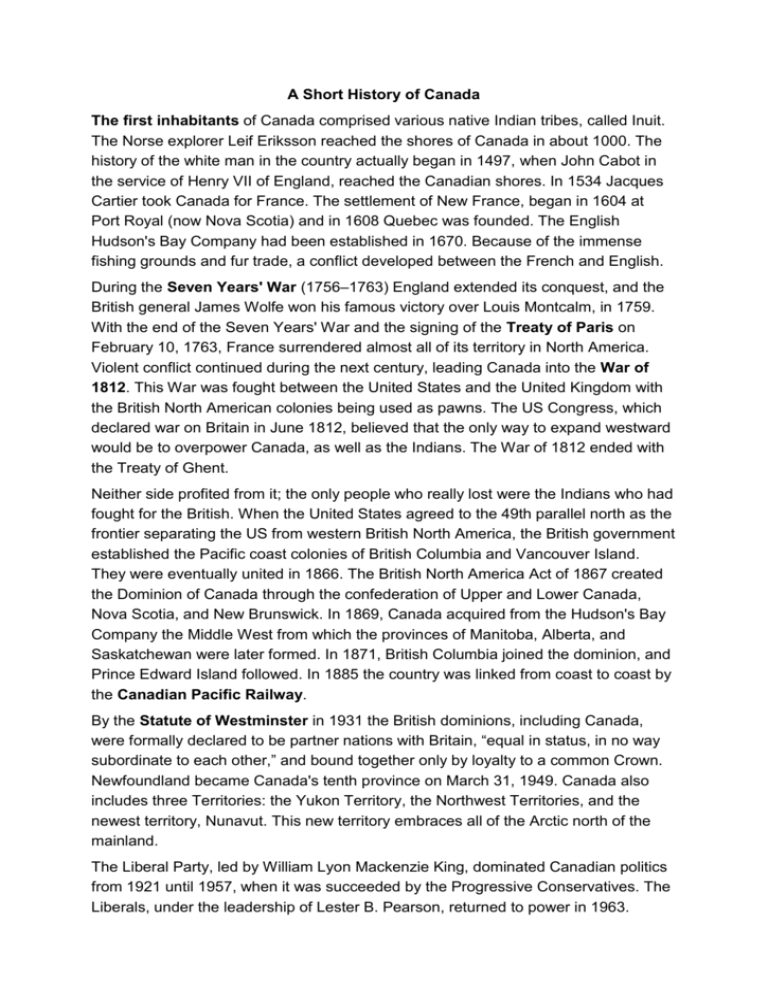
A Short History of Canada The first inhabitants of Canada comprised various native Indian tribes, called Inuit. The Norse explorer Leif Eriksson reached the shores of Canada in about 1000. The history of the white man in the country actually began in 1497, when John Cabot in the service of Henry VII of England, reached the Canadian shores. In 1534 Jacques Cartier took Canada for France. The settlement of New France, began in 1604 at Port Royal (now Nova Scotia) and in 1608 Quebec was founded. The English Hudson's Bay Company had been established in 1670. Because of the immense fishing grounds and fur trade, a conflict developed between the French and English. During the Seven Years' War (1756–1763) England extended its conquest, and the British general James Wolfe won his famous victory over Louis Montcalm, in 1759. With the end of the Seven Years' War and the signing of the Treaty of Paris on February 10, 1763, France surrendered almost all of its territory in North America. Violent conflict continued during the next century, leading Canada into the War of 1812. This War was fought between the United States and the United Kingdom with the British North American colonies being used as pawns. The US Congress, which declared war on Britain in June 1812, believed that the only way to expand westward would be to overpower Canada, as well as the Indians. The War of 1812 ended with the Treaty of Ghent. Neither side profited from it; the only people who really lost were the Indians who had fought for the British. When the United States agreed to the 49th parallel north as the frontier separating the US from western British North America, the British government established the Pacific coast colonies of British Columbia and Vancouver Island. They were eventually united in 1866. The British North America Act of 1867 created the Dominion of Canada through the confederation of Upper and Lower Canada, Nova Scotia, and New Brunswick. In 1869, Canada acquired from the Hudson's Bay Company the Middle West from which the provinces of Manitoba, Alberta, and Saskatchewan were later formed. In 1871, British Columbia joined the dominion, and Prince Edward Island followed. In 1885 the country was linked from coast to coast by the Canadian Pacific Railway. By the Statute of Westminster in 1931 the British dominions, including Canada, were formally declared to be partner nations with Britain, “equal in status, in no way subordinate to each other,” and bound together only by loyalty to a common Crown. Newfoundland became Canada's tenth province on March 31, 1949. Canada also includes three Territories: the Yukon Territory, the Northwest Territories, and the newest territory, Nunavut. This new territory embraces all of the Arctic north of the mainland. The Liberal Party, led by William Lyon Mackenzie King, dominated Canadian politics from 1921 until 1957, when it was succeeded by the Progressive Conservatives. The Liberals, under the leadership of Lester B. Pearson, returned to power in 1963. Pearson remained Prime Minister until 1968, when he retired and was succeeded by Pierre Elliott Trudeau. Trudeau maintained Canada's defensive alliance with the United States but began moving toward a more independent policy concerning world affairs. Faced with an escalating violent separatist movement in the Frenchdominated province of Quebec, Trudeau introduced the Official Languages Bill, which encouraged bilingualism in the federal government. In 1976, the Parti Québécois (PQ) won the provincial Quebec elections, and René Lévesque became premier. The Quebec government passed Bill 101 in 1977, which established numerous rules promoting French-speaking culture. Quebec held a referendum in May 1980 on whether it should seek independence from Canada; it was rejected by 60% of the voters. In September 2012, the PQ returned to power as a minority administration. The Canadian monarchy is the system of government by which an hereditary monarch is the sovereign of Canada, holding the position of head of state. Today this is Elizabeth II, officially called Queen of Canada. Most of the Queen's powers in Canada are exercised by the Governor General. The Governor General deals with the monarch directly and serves as her federal representative. Queen Elizabeth II signed the Constitution Act (also called the Canada Act) in Ottawa on April 17, 1982, thereby cutting one of the last legal ties between Canada and Britain. The constitution maintains Queen Elizabeth as Queen of Canada and keeps Canada's membership of the Commonwealth. Every province except Quebec accepted this constitution. In the General Election on Sept. 4, 1984, the Progressive Conservative Party achieved an overwhelming victory, fundamentally changing the country's political landscape. The Conservatives, led by Brian Mulroney, won the highest political majority in Canadian history. The issue of separatist sentiments in French-speaking Quebec intensified again in 1990 with the failure of the Meech Lake Accord. The accord was designed to bring Quebec into the constitution while reducing its residents' fear of losing their identity within the English-speaking majority. On April 1, 1999, the Northwest Territories were officially divided to create a new territory in the east that would be governed by Canada's Inuits, who make up 85% of the area's population. In recent years, Canada has introduced some of the world's most liberal social policies. Marijuana for medical patients was legalized in 2001. In July 2005, Canada legalized gay marriage throughout the country. Canada sent 2,000 soldiers to help fight the U.S.-led war in Afghanistan, but its relations with the U.S. were troubled when it refused to join Washington's coalition supporting the war in Iraq. In 2010 the mountain resort of Whistler in British Columbia organized the XXI Olympic Winter Games.

